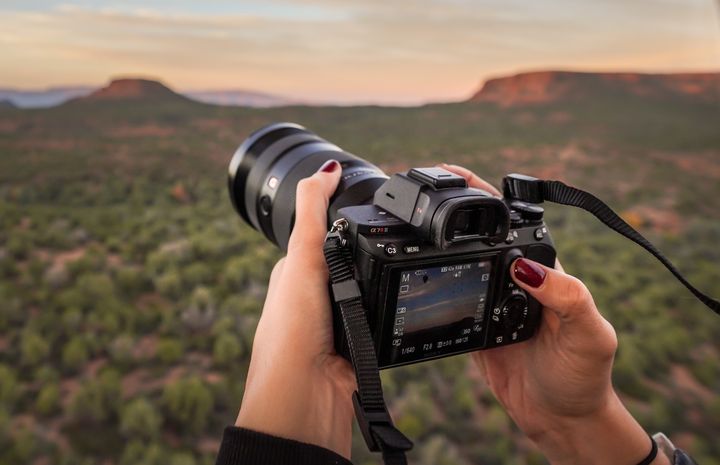
Sony a7RIII
Go ahead and mark this date on your calendars as the day Sony officially overtook both Canon and Nikon with a full frame professional camera. In just 3 generations we have watched the Sony a7R go from a cool concept with a few decent lenses to a professional powerhouse camera with the glass to match. While on paper the Sony a7RIII is just a slightly upgraded a7RII (Check out the Sony a7RIII vs a7RII), after spending several days shooting with this camera in a variety of environments alongside the Canon 5D Mark IV and Nikon D850, the a7RIII represents something far greater.
Body / Hardware

Since its inception, this body has always been my least favorite part of the Sony A7. Sure it was small, but that size also meant fiddly controls, small grips, a worthless battery and missing features like dual card slots. And while the a7RIII looks almost identical to the a7RII (check out the a7RIII vs a7RII Review), there are massive improvements that completely revolutionized the shooting experience. The dials now feel great with plenty of feedback, a joystic provides easy focus point changes, and the camera offers dust and moisture resistance. The screen also offers touch focus, we now have a larger battery for all day shooting, and dual card slots mean event photographers can rest easy. Of course those are all items that Canon and Nikon photographers have enjoyed for years but the a7RIII continues to up the competition by adding a USB C port for charging, offering class leading 10fps shooting (8fps with live view & 14 bit RAW), and an EVF that is finally ready to take on optical viewfinder quality while offering you a realistic preview of your image before you touch the shutter. Things are not perfect though and while the body is significantly smaller and lighter than the competition, you might need to add a battery grip for a better handling with larger lenses and at times my hands felt a bit cramped. Setting up the camera can also be a struggle with a jumbled menu layout combined with the advanced and often confusing feature set.
Features

The Sony a7RIII also comes loaded with features such as a pixel shift mode for high detail captures, intelligent eye autofocus, silent modes, and 5 axis in body image stabilization. That image stabilization system offers a huge benefit over the competition as every electronic lens including wide aperture primes will now have up to 5.5 stops of stabilization. In reality the system worked well and I was able to shoot with slower shutter speeds and shoot with a steady viewfinder. The crazy autofocus system with 399 phase detection points and 425 contrast detect points covering 68% of the frame and overall it offers DSLR like performance with greater coverage and more intelligent tracking. Unfortunately my results were not perfect with eye AF on portraits and while the tracking worked well, it didn’t always focus perfectly on my subjects eye. The silent shutter also allows shooting at up to 10fps but you will see rolling shutter unlike the Sony A9 which virtually eliminated it so best to keep that limited to non moving and slow moving subjects. It’s still better than anything we have from DSLRs though. One missing feature though is a built in intervalometer so timelapses will require a separate controller (more on that here).
Field Usability

With any professional camera what matters the most is usability in the field and under pressure in difficult environments the a7RIII felt ready to tackle the best DSLRs. The autofocus system was great, controls where I needed them to be, I had a few more accidental button presses than with my Nikon and Canon cameras but the layout and tactile feel was on point. Using an electronic viewfinder is also amazing as you can see your exposure before ever snapping a picture though it can be confusing going from this bright viewfinder to a dim screen and I found myself checking the histogram a bit more than normal in bright lights. I was able to try out the pixel shift feature and keep in mind that these are already extremely large and detailed files so you will have to zoom in at least 200% to even notice a difference. It also requires a completely still subject as well as a still camera and the file has to be processed in post, but if you zoom in far enough, there is a small improvement to detail and color information. Sony’s 10fps maximum burst rate is definitely impressive but with 42mp files, that can fill up quickly and the buffer can be slow to clear. Plus with only 1 UHS-II card slot, shooting uncompressed RAW to both cards can start to fill things up. While I personally never filled the buffer up completely in normal shooting, there are some functions of the camera that are limited while things are clearing. You can quickly play back to review settings but most menu items are locked out and you can’t shoot video until the buffer clears. If you need to shoot high speed uncompressed RAW to both cards without a break between bursts, this could slow things down.
Image quality

The quality from the Sony a7RII has always been amazing and while the a7RIII uses the same sensor, improvements with the electronics and processing give just a bit more dynamic range. Colors have also shifted a bit and I found skin tones have improved although I still personally have a slight preference towards Canon. Low light results were also impressive especially when you consider that this is a 42mp sensor with 6400 ISO looking good and 12,800 ISO still usable. No matter how you stack it, the a7RIII offers some of the best quality available from any full frame camera.
Video

Again, video has always been great on Sony mirrorless cameras and the a7RIII takes things up a notch. The 4k video at up to 30fps stays the same but the quality in full frame mode has vastly improved. The a7RIII also offers a super 35 crop mode which further increases the quality by oversampling from a 5k area to produce even more detail and reduced moire. You also now have 1080p at 120fps which are all class leading features. I’ve always loved Sony’s inclusion of video functions like focus peaking, log recording, and now even HLG for high dynamic range, so again the a7RIII gives us the best of any competing camera. On the bad side the screen isn’t as bright as I would like, touch autofocus has just a bit of lag, and you are limited to 8 bit video. But overall you will not find a better photography camera with more amazing video.

Conclusion
Like I said before, the Sony a7RIII represents a new shift for professional full frame cameras where mirrorless technology no longer brings a host of negatives and instead offers some amazing features, solid image quality, and unbeatable video. Features like 5 axis image stabilization in camera, silent shooting options, focus points even in the corners, and eye AF were more than just a gimmicks and they actually allowed me to capture better images. Everyone has their favorite brand where they love whether for the colors, ergonomics, lenses, or just brand loyalty but at this point there is no denying that Sony has produced a superior camera in almost every way for almost every industry. Going forward, the a7RIII will be the camera to beat for full frame professionals looking for the ultimate in image quality, features, and performance.
More information: Learningcameras
